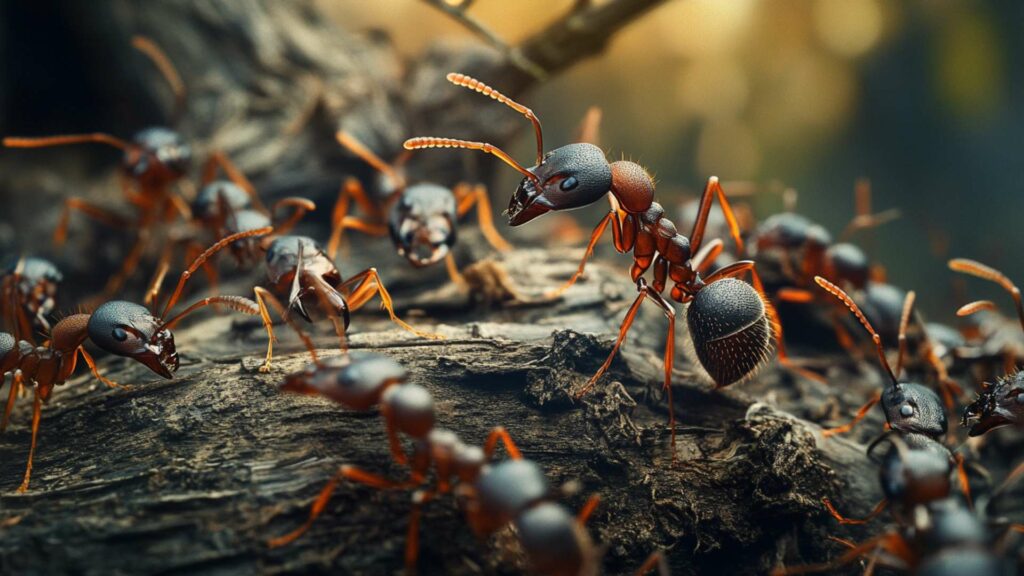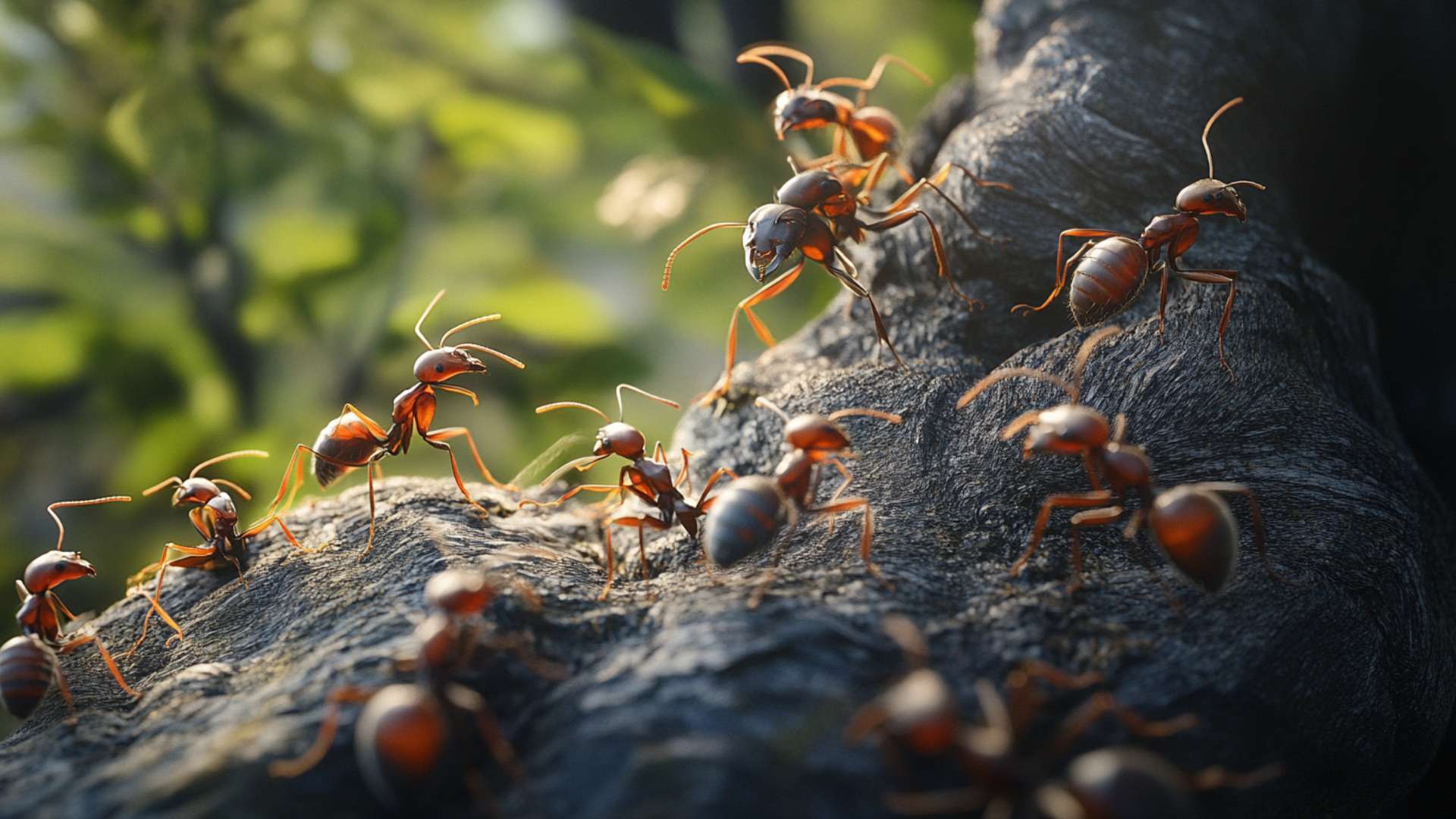Fascination with ants and their remarkable abilities: Ants: these tiny creatures have captivated the curiosity and imagination of humans for centuries. Their highly organized societies, unwavering work ethic, and complex communication systems have ignited our fascination with these industrious insects.
But it is not just their social structures that have intrigued us; ants possess an array of extraordinary abilities that continue to astound researchers and enthusiasts alike. In recent years, the concept of 360-degree vision in ants has emerged as a topic of interest.
We often marvel at the agility with which ants navigate their surroundings, seemingly aware of obstacles in every direction. But how do they accomplish this?
Do ants truly possess the ability to see in all directions simultaneously? In this article, we will dive deep into the realm of ant vision, exploring whether or not they indeed exhibit 360-degree sight.
Fascination with Ants and Their Remarkable Abilities

Within the world of animal species, ants hold a unique place. These miniature creatures come in a wide variety of sizes and designs, from smaller ants that vary dramatically in appearance to bigger ones that can be easily spotted scurrying around. However, it is not just their physical characteristics that make them interesting; it is also their unparalleled cooperative behavior.
Ants are known for their collective food transport efforts. They create efficient highways by following chemical trails left by other members of their colony.
This coordinated action allows them to gather resources for the entire community swiftly. Moreover, when faced with an obstacle along their path—let’s say a sugar solution feeder or even other insects—they demonstrate remarkable problem-solving skills.
While smaller ants may detect an obstacle directly blocking their way and quickly find alternate routes using trial-and-error tactics or even detouring around it, bigger ants often adopt a traffic light-like system, indicating to others whether they should wait or move around. These examples exemplify the impressive abilities of ants and their capacity to navigate their environment effectively.
Exploring the Concept of 360 Vision in Ants
When we think about vision, it is often associated with forward-facing eyes like those found in humans and many other animals. However, for ants, the concept of vision takes on a whole new dimension. While they may not possess eyes as large or complex as ours, their visual system is designed to encompass a much wider field of view.
Ants primarily rely on compound eyes composed of numerous individual lenses called ommatidia. This compound eye structure allows for panoramic vision, enabling them to capture an expansive range of visual information from various directions simultaneously.
While this type of vision may have less spatial acuity compared to what humans experience with our single-lens eyes, it provides ants with an extraordinary advantage: the ability to scan their surroundings in all directions at once. The relationship between ant vision and 360-degree perception is both intriguing and complex.
How do these miniature creatures process this wealth of visual data? Do they see every detail or rely on specific cues?
Is there a difference in visual capabilities between smaller ants and their larger counterparts? In the upcoming sections, we will delve into these questions and explore the fascinating world of ant vision.
Understanding Ant Vision
Ants, those minuscule yet incredibly industrious creatures, possess a range of fascinating visual abilities. To understand how they perceive the world around them, we must first delve into the intricacies of their eyes.
Ants have what is known as compound eyes, most ants which consist of numerous tiny lenses called ommatidia. These lenses work together to form a mosaic-like image.
Interestingly, each ommatidium captures a small portion of the overall image, contributing to a highly detailed composite visual representation. The structure of an ant’s compound eyes varies depending on the species and its specific needs.
Some ants have eyes that are located on the sides of their heads, allowing for a wider field of view and better detection of potential threats or food sources. Others may have eyes positioned closer to the front, providing improved depth perception for precise object manipulation.
Different types of ant eyes and their functions
Within the realm of ants, there exist various eye configurations tailored to different tasks. For instance, worker ants typically possess smaller but numerous ommatidia in their compound eyes.
This adaptation allows them to without visual navigation ability focus more on close-range activities such as foraging or obstacle avoidance behavior within the confined spaces they encounter underground or within intricate vegetation. On the other hand, flying ants require a different visual strategy due to their aerial nature.
These winged insects often have larger compound eyes with increased reliance on motion detection capabilities to navigate through complex three-dimensional environments effectively. It’s important to note that not all ants rely solely on compound eyes for vision; some species also possess additional simple eyes called ocelli located near the top of their heads.
While these ocelli are less effective at capturing detailed images compared to compound eyes, they play a vital role in detecting light and dark variations in ambient conditions. This additional sensory input complements the compound eyes’ functions and enhances an ant’s overall visual navigation abilities.
By understanding the diverse eye structures and functions among ants, we gain insights into how their visual systems have evolved to suit their specific ecological niches. This knowledge not only piques our curiosity about these remarkable creatures but also has the potential to inspire advancements in fields such as robotic vision or designing efficient navigation technology.
The Field of View in Ants
Ant vision, although different from human vision, plays a crucial role in how ants navigate and interact with their environment. Unlike humans who rely on two large eyes for sight, ants have compound eyes consisting of several smaller units called ommatidia. Each ommatidium functions like a tiny eye, contributing to the overall visual perception of the ant’s world around.
These compound eyes are well-suited for detecting motion and changes in light intensity rather than providing high-resolution images. So, while ants may not see the world as clearly as we do, their visual system is finely attuned to pick up crucial cues for their survival.
Examining the range of vision in different ant species
The range of vision in ants varies across different species. Smaller ants have fewer ommatidia compared to larger ones, resulting in blurry vision and less spatial acuity.
The number of ommatidia can range from a few hundred to tens of thousands depending on the ant species. For instance, smaller ants like pavement ants or pharaoh ants may have around 100-200 ommatidia per compound eye, whereas larger species of miniature ants like carpenter ants can possess up to 10,000 ommatidia per eye.
The field of view also varies between walking insects and flying insects within an ant colony. Winged males and females (reproductives) have larger eyes compared to worker ants since they require more acute vision for tasks such as finding mates or navigating during mating flights.
Worker ants’ field of view is primarily focused downwards towards the ground due to their role as ground-dwelling foragers. Ants detect various wavelengths including ultraviolet light that are invisible to humans; this ability aids certain visual navigation abilities such as recognizing landmarks or identifying other members belonging to their own colony.
It’s fascinating to think about how these tiny creatures navigate their world by relying on their compound eyes and perceiving the environment in a unique way. Overall, while ants may not possess the same level of visual acuity as humans, their compound eyes provide them with valuable information for obstacle avoidance, traffic light recognition within their intricate social structures, and successful foraging behaviors.
Compound Eyes: The Key to 360 Vision?
Ants, those tiny yet remarkably organized creatures, possess a visual system that is truly extraordinary. At the heart of their exceptional vision lies an ingenious structure known as compound eyes.
Unlike our own single-lens eyes, an ant’s compound eyes consist of thousands of individual lenses called ommatidia. These ommatidia work together to form a mosaic-like image that allows ants to perceive their surroundings in astonishing detail.
The advantages of compound eyes for ants are manifold. Firstly, this complex visual apparatus grants them an unrivaled panoramic view.
With thousands of ommatidia at their disposal, ants can detect movement and changes in light and dark from a wide range of angles simultaneously. This ability proves crucial for their survival and navigation within the world they inhabit.
Detailed analysis of how compound eyes contribute to a wider field of view
To truly appreciate how compound eyes contribute to the expansive field of view in ants, let us delve into some numbers. While humans typically have a field of vision spanning approximately 180 degrees horizontally, most ant species boast an impressive field of view exceeding 200 degrees! In certain cases, this range can even extend up to a staggering 360 degrees.
The secret behind this wide-angle perception lies in the overlapping visual fields created by each ommatidium. These small individual lenses provide specific segments or tiles of visual information which, when combined with information from neighboring ommatidia, form a comprehensive composite image for the ant.
By integrating these multiple viewpoints effectively, ants achieve what appears to be all-around vision—an ability we find ourselves longing for at times! Thanks to their compound eyes’ impressive coverage and integration capabilities, ants excel at detecting obstacles and navigating complex terrain effortlessly.
Whether it’s avoiding predators, locating food sources, or undertaking epic journeys back to their nests, their wide field of view allows them to effectively detect and respond to potential threats or opportunities. It’s as if they possess an innate GPS system, carefully designed by nature over millions of years for efficient navigation.
Intriguingly, despite these advantages, not all ants have perfect 360-degree vision. Smaller ants often vary dramatically in terms of their visual capabilities and field of view.
Some species of avoidance ants may rely more on other senses or employ different strategies to navigate their environment successfully. Nonetheless, the fascinating world of ant vision opens up a realm of possibilities for understanding and perhaps even designing more efficient navigation technology inspired by these incredible tiny creatures.
Overlapping Visual Fields: Achieving Full Coverage

One of the most captivating aspects of ant vision is the way their visual fields overlap, allowing them to achieve an impressive level of coverage. Imagine if you could see in all directions simultaneously, without having to turn your head or rely on peripheral vision – that’s essentially how ants perceive the world around them. Unlike humans and many other animals, ants don’t have a single focal point of vision.
Instead, their compound eyes consist of numerous tiny lenses called ommatidia, each capturing a small portion of their surroundings. These individual ommatidia create a mosaic-like image that is then processed by the ant’s brain, resulting in a comprehensive and panoramic view.
Enhancing Perception: How Overlapping Fields Benefit Ants
The overlapping visual fields in ants provide them with several advantages when navigating their complex environments. Firstly, this arrangement enables ants to detect obstacles and potential threats from multiple angles simultaneously. For example, when foraging for food, an ant’s eye vision can effectively spot predators or barriers approaching from any direction.
Furthermore, the overlapping visual fields enhance an ant’s ability to interpret visual cues accurately. By having multiple perspectives on an object or landmark within their surroundings, ants can better gauge distances and make more precise spatial judgments.
This exceptional capability becomes particularly vital when it comes to tasks like homing or navigating back to their colony. Additionally, the overlapping nature of their visual fields aids in obstacle avoidance by reducing blind spots.
Since smaller ants might encounter obstacles that are not readily perceptible from a single viewpoint alone, having overlapping fields compensates for this limitation and allows them to react quickly and efficiently. Overlapping visual fields empower ants with comprehensive situational awareness in their intricate world.
It enables them to perceive objects accurately, gauge distances effectively, and react promptly to obstacles or potential threats. Such a remarkable adaptation showcases the ingenuity of nature and highlights the extraordinary visual capabilities possessed by these tiny creatures.
Limitations and Adaptations
In the world of ants, vision is not without its limitations. Various factors can impact an ant’s field of view, including the dead ant’s eye, head size, and body position. Just like in humans, smaller ants have eyes that are closer together, limiting their peripheral vision.
For instance, desert ants, known for their impressive visual navigation abilities, have larger heads and eyes positioned further apart to overcome this limitation. On the other hand, fire ant species with their smaller heads vary dramatically in their visual capabilities.
Ingenious Adaptations: Overcoming Visual Limitations
To overcome the constraints posed by head size or body position, some ant species have developed unique adaptations. These adaptations enable them to make the most out of their visual perception abilities. For example, weaver ants exhibit a fascinating behavior called “traffic light” communication.
They use minimal visual information to signal nest direction to other colony members by positioning themselves at specific angles on leaves or branches. This intricate behavior showcases how ants cleverly utilize visual cues despite potential limitations of artificial vision technology.
Case Study – Weaver Ants: Masters of 360 Vision?

The Remarkable Vision Capabilities of Weaver Ants
When it comes to exceptional field of view among ants, weaver ants deserve special attention as they display remarkable visual capabilities. With their compound eyes positioned on either side of their head and a panoramic view enabled by overlapping fields of vision from each eye, these industrious insects possess what could be considered a form of 360-degree vision.
Showcasing Extraordinary Behaviors
Weaver ants demonstrate specific behaviors that highlight their exceptional field of view and utilization of 360-degree vision. For instance, during nest construction or when defending against predators or rival colonies, weaver ants coordinate seamlessly to accomplish complex tasks.
They possess a keen ability to visually perceive obstacles and react accordingly, detouring around them with precision. This deftness in both obstacle avoidance behaviour detection and navigation is a testament to the incredible visual prowess of these tiny creatures.
Evolutionary Significance
Advantages of 360 Vision for Ants
The evolutionary significance of 360 vision in ants lies in the advantages it offers for their survival and success. With a wider field of view, ants gain increased awareness of their surroundings, allowing them to detect potential threats or food sources more effectively. This enhanced visual perception aids in optimizing foraging and nest-building activities, ultimately contributing to the overall success of an ant colony.
Speculating on Visual Evolution
While the precise details of how ants developed 360 vision remain speculative, scientists believe that this visual adaptation likely evolved over time as ants faced challenges associated with their complex social structure and specialized ecological niches. It is plausible that ants with broader fields of view had an evolutionary advantage in terms of resource acquisition, predator detection, and navigation abilities within intricate habitats.
Conclusion
While most species have limitations on their field of view due to factors like head size or body position, certain ant species have astoundingly overcome these obstacles through ingenious adaptations. Weaver ants serve as an intriguing case study with their mastery over 360-degree vision and display extraordinary behaviors reflecting this exceptional ability.
The evolutionary significance lies in the advantages offered by a wider field of view for various aspects of an ant’s life—from detecting threats to facilitating efficient foraging and nest construction. As we continue our exploration into the world of ants’ visual perception abilities, further research holds immense promise for unraveling more secrets about these fascinating creatures’ exceptional visual adaptations
Dissuade Ants with D-Termination: The Leading Pest Control Service in Las Vegas!

If you’re dealing with ant problems, don’t worry. D-Termination is here to help. Our team of experts specializes in discouraging ants, revitalizing cleanliness, and restoring the integrity of your space. Bid farewell to ants—opt for D-Termination for highly effective pest control today!
You can reach us at 702-919-6310 or visit dtermination.com to schedule your ant control service and take back your space from these unwanted pests.
Frequently Asked Questions:
Ants may have 360-degree vision, but their vision is often limited.
Ants have simple eyes called ocelli that can detect light and dark.
Ants are considered visually limited or even blind by human standards.
Ants have poor eyesight and rely more on their other senses like touch and smell.








